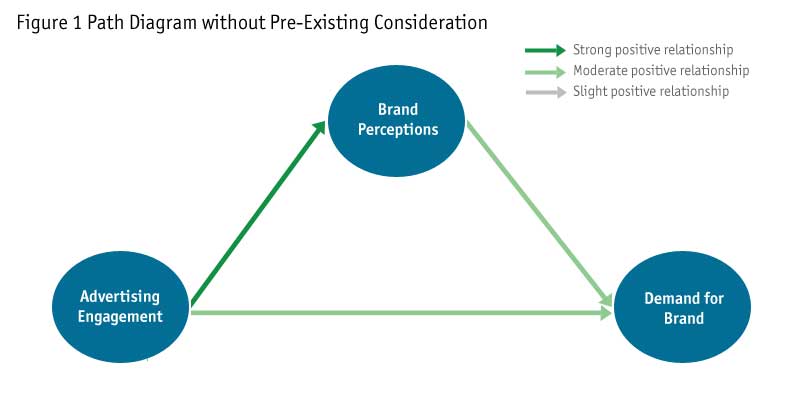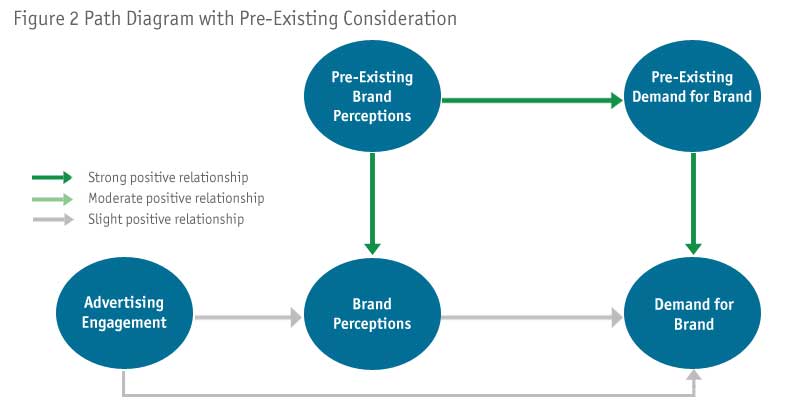Editor’s note: Trevor Kvaran is vice president, analytics at marketing research firm Communicus, Tucson, Ariz.
In advertising research, delivering great insight begins with asking the right questions, collecting the right data and applying the right analytical methods. Sometimes the most effective methods are also some of the most obscure.
I have been using a longitudinal research design for many years but have been surprised by how many researchers are unfamiliar with it. In this article, I will look at a simplified example that highlights why longitudinal data is so useful in understanding advertising effectiveness.
Structural equation modeling
When trying to determine the impact of advertising on shifting purchasing behavior, as well as evaluate precisely how a campaign had effected this change, many analytical teams use a structural equation modeling (SEM) approach.
Providing insights into the ways purchasing behavior changes over time requires data that speaks to how people change and an analytical plan that accommodates this. This originates with a longitudinal research design measuring individual consumers at multiple points in time. Failing to implement this longitudinal component can lead to wildly misleading conclusions about the effects of advertising.
SEM is a multivariate analytical technique that can be used to model complex relationships between latent variables. In this simplified case, I suggest a causal model composed of three latent constructs:
- advertising engagement;
- brand perceptions; and
- demand for the brand’s products or services.
These latent variables are constructed using a confirmatory factor analysis. This model is tightly focused on only three latent constructs but in practice, SEM models can be used to provide a clear picture of how numerous factors can both affect consumer behavior and be affected by marketing efforts.
Once researchers define the variables, they can build an SEM model to determine the causal relationships between advertising engagement, brand perceptions and product demand. For the example I introduced above, I would obtain data for the variables by conducting a survey at two different points in time to measure consumers’ brand perceptions, purchasing behavior (demand) and engagement with advertising, measuring each of these constructs with several manifest variables.
To highlight how longitudinal data can dramatically influence our interpretation of the success of the advertising, let’s use two different SEM models. One looks at a single point in time and one includes data from both points in time. If we use these three variables at a single point in time, we obtain a model in which advertising has a significant measurable effect on perceptions and demand. As seen in Figure 1, advertising has a strong positive effect on perceptions and a moderate positive effect on demand. Perceptions moderately drive demand and through perceptions, advertising has an additional, slightly positive effect on demand. In this view, it appears that advertising is working well to drive brand perceptions and demand.

Measuring at two points in time
But Figure 1 does not tell the whole story. With longitudinal data, we can measure brand perceptions and demand at two points in time. When we add pre-existing brand perceptions and pre-existing demand to the model (Figure 2), we see that the effect of advertising diminishes now that we’ve accounted for the state of consumers’ brand perceptions and demand prior to the advertising campaign. Pre-existing perceptions drive pre-existing demand, and the pre-existing conditions have a strong positive effect on current perceptions and demand. Advertising still has a positive effect on both perceptions and demand, and there is still a small positive indirect effect of advertising on demand through perceptions. But the relationship between current and pre-existing conditions is very strong, which diminishes the overall advertising effect. We must consider pre-existing brand perceptions and demand in order to truly understand the effect of an advertising campaign and obtain a complete picture of how advertising works to shift consumer behavior.

The key takeaway from this analysis is how deceiving point-in-time data can be. In the initial point-in-time model, the advertising campaign looks surprisingly strong. But this model does not fully address the key questions. The point-in-time analysis doesn’t explain whether consumer perceptions were affected or changed based on advertising exposure. This becomes clearer once we incorporate multiple time points into the analysis. While the answer wasn’t as positive as hoped, the longitudinal model provided us with a truer representation of how effective the advertising campaign had been, which is the insight we were ultimately looking for.
A comprehensive view
Settling for anything less than a comprehensive view of the impact of advertising will lead to less-informed, less-effective campaign strategies and execution in the future. Few brands have enough dominance of their markets to ignore such complete insights, especially as longitudinal models of measuring impact are equally available to competitors. You can perfectly phrase your questions and seek all the right data, but none of it will matter if you fail to apply the correct analytical methods.
